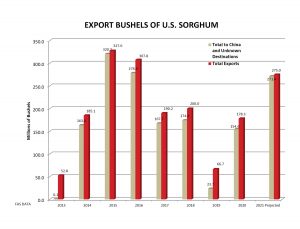
Swipe For More >
Seeking Profit in 2021? Sorghum Demand Signals Opportunity
The outlook for sorghum demand in 2021 is very bright, and utilizing key marketing and decision making techniques can help sorghum farmers take advantage of the profit potential offered this year.
With strong demand for sorghum in 2020, producers saw record prices not only at the port but at the farm gate, as well. It is a bright spot in a year that presented more than its fair share of challenges and change. While there are many things that can be left behind in 2020, producer profitability on sorghum acres is not one of them.
Historical data shows that prices typically plateau or decrease as farmers bring in the harvest. This year told a different story. Not only did basis move up as the South Texas sorghum harvest began, it moved up leaps and bounds as harvest progressed north.
Sorghum basis made the jump from even or slightly negative in late winter and early spring to +200 at the end of 2020. Driving this demand was the return of China’s hog population after the population was decimated in 2018 by African Swine Fever (ASF).
Changes in regulations to control the spread of ASF have shifted all pork production to commercial operations that need coarse grains for feed. Historically, there were a lot of small backyard operations feeding less complex rations. With pork production back online, China’s 2021 import needs of coarse grains are expected to be nearly double the amount imported in 2020.
The demand picture for sorghum in 2021 remains bright. Certainly, that can change, and this doesn’t immunize markets from the list of items that, on a large scale, are out of the farmers hands when it comes to managing risks. Temperatures, rainfall, and pest pressure are all considerations as well, and while they cannot be controlled, they can be managed with the right approach.
Sorghum demand for 2021 is reflected in new crop bids available as this article is being written. There are container shipments of sorghum on the books, and the ingredients for another great year in sorghum marketing are coming together quickly. This sets the stage for profit opportunities for sorghum farmers, but producers must prepare and take the needed steps ahead of time for a marketing strategy to be a true success.

Set Up a Production Budget
So where do producers start? Compiling the tools farmers have available will help with a lot of decisions. Put together production budgets for all the potential crops that can be grown on an enterprise. Pay close attention to the costs of production, expected production and current new crop bids. Most importantly, know what each crop’s potential return on investment is.
Many of the state extension services have a good foundation to help producers build budgets. They can be found on websites such as Agmanager.info, which right now is showing dryland budgets for northeast Kansas are favorable to sorghum by $164.41 per acre over corn.
If producers need help finding these resources, they can reach out to staff at the Sorghum Checkoff. They are happy to help! It is most important when making these decisions to have an accurate understanding of the numbers. That means dollars going out and coming in.
Develop Grain Marketing Strategy
Next, develop a grain marketing strategy, and stick to it. There are many different strategies here and many things that come into play. Weigh all options. Is there access to on-farm storage that may allow contracting for later delivery? Where are the best bids within the region? How do producers utilize options contracts? How many bushels should be contracted?
Mick Rausch, a south central Kansas sorghum farmer, has changed his strategies over the years.
“I used to take a very conservative approach, waiting until I had every bushel in the bin, so I knew exactly what I had to sell,” said Rausch. “That didn’t always work out in the best interest of my pocket book.
“Today, if I see a profit to be had, I put some on the books—not the whole farm—but something like 5 percent of my expected production at a time.”
Rausch said he still struggles at times with the thought of selling something that isn’t even planted yet, but knows that he has other tools such as crop insurance that provide a backstop if a disaster were to strike.
Sticking to the Plan
Developing a plan can be overwhelming. There is a lot that goes into building one and understanding and weighing trading options. Do not be hesitant to reach out for help. There are many training courses for farmers on marketing available today. Or consider hiring a group to help build a plan. There is no shame in that either. The last thing farmers want to do is leave money on the table.
Every operation is different, and plans are not a one size fits all. A calculated, well considered plan will keep producers from making knee-jerk, emotional marketing decisions, which can lead to additional stress or poor decisions, resulting in loss of profitability. Take advantage of profits as they present themselves.
“Don’t worry about hitting the high,” Rausch added, “it will help you avoid hitting the low. Just take the profit, and don’t look back!”
###
This story originally appeared in the Winter 2021 Issue of Sorghum Grower magazine.


